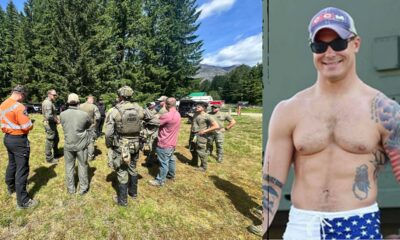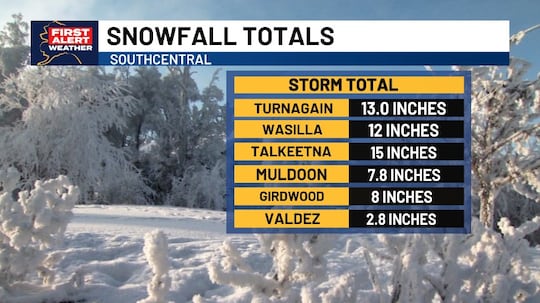Alaska
University of Alaska Board of Regents to consider merger of two Interior campuses

FAIRBANKS, Alaska (KTVF) – COVID-19 pandemic-era digital shifts in postsecondary education are contributing to a new proposal to consolidate two University of Alaska campuses.
The University of Alaska Fairbanks (UAF) submitted the idea, which would see its Interior Alaska Campus (IAC) fall under the umbrella of the Community Technical College (CTC).
“We think merging the expertise of CTC with the relationships that IAC has and their knowledge of serving rural students is really in the best interest for the students in the Interior region as a whole,” UAF Vice Chancellor for Rural, Community and Native Education Charlene Stern said Tuesday.
The CTC has over 50 certificate and degree programs, with studies ranging from aviation maintenance to nursing, and its main building sits near the outer edge of downtown Fairbanks, along Barnette Street.
The IAC serves dozens of rural communities in the state. It has five subregions — Tok, McGrath, Nenana, Yukon Flats and Yukon-Koyukuk — but the hub is in Fairbanks at the Harper Building on UAF’s campus.
The IAC lists six academic programs on its website, including study areas such as tribal governance and content creation.
Before the pandemic, IAC was often the sole higher-ed provider in rural communities, and did so via on-site teaching and learning, according to Stern.
But the COVID-19 pandemic altered landscape of post-secondary education as many programs moved onto the computer screen, a cultural phenomenon that fast-tracked the evolution of online classes and changed some students’ preferred methods for taking and completing courses.
“What ended up happening with the pandemic is so many other providers put things online, and then students enjoyed, for the most part, that greater access, and didn’t necessarily have to go through some of these campuses anymore for educational opportunity,” Stern said.
A UAF fact sheet shows IAC enrollment dropped almost 25% between 2019 and 2020, from 349 to 264. Enrollment hasn’t recovered in the years since, with 255 in 2021, 259 in 2022 and 264 in 2023.
About 2,300 students made up CTC’s student body in 2023, equating to approximately 31% of UAF’s enrollment. CTC’s enrollment is also lower when compared to 2019 levels but represents a smaller percentage decrease at 9.5%.
Precisely which CTC programs the university would deliver to the IAC communities is yet to be determined. Many of the expanded course and program offerings would be online, but Stern added that traveling instructors could enable some in-person CTC course offerings in the remote communities IAC currently serves.
She said consolidating the campuses under the banner of CTC might result in minor savings but that the budget wasn’t the main driver behind the proposal.
“This move is consistent with our general approach and valuing of serving all of the regions across Alaska and looking individually at the needs of different regions and trying to be responsive to those needs,” Stern said.
UAF says IAC students should not expect disruptions to their current academic programs under the proposal. The university also says IAC employees would transfer to CTC but that no job losses are anticipated.
The UA Board of Regents will take up the proposal at its Nov. 7 and Nov. 8 meeting in Fairbanks, though a UAF spokesperson said the agenda will not be posted until “later this week.”
If passed, the merger would go into effect July 1, 2025.
Download the Newscenter Fairbanks apps today and stay informed with the latest news and weather alerts.
Copyright 2024 KTVF. All rights reserved.

Alaska
National Native helpline for domestic violence and sexual assault to open Alaska-specific service
Alaska
Dozens of vehicle accidents reported, Anchorage after-school activities canceled, as snowfall buries Southcentral Alaska

ANCHORAGE, Alaska (KTUU) – Up to a foot of snow has fallen in areas across Southcentral as of Tuesday, with more expected into Wednesday morning.
All sports and after-school activities — except high school basketball and hockey activities — were canceled Tuesday for the Anchorage School District. The decision was made to allow crews to clear school parking lots and manage traffic for snow removal, district officials said.
“These efforts are critical to ensuring schools can safely remain open [Wednesday],” ASD said in a statement.
The Anchorage Police Department’s accident count for the past two days shows there have been 55 car accidents since Monday, as of 9:45 a.m. Tuesday. In addition, there have been 86 vehicles in distress reported by the department.
The snowfall — which has brought up to 13 inches along areas of Turnagain Arm and 12 inches in Wasilla — is expected to continue Tuesday, according to latest forecast models. Numerous winter weather alerts are in effect, and inland areas of Southcentral could see winds up to 25 mph, with coastal areas potentially seeing winds over 45 mph.
Some areas of Southcentral could see more than 20 inches of snowfall by Wednesday, with the Anchorage and Eagle River Hillsides, as well as the foothills of the Talkeetna Mountain, among the areas seeing the most snowfall.
See a spelling or grammar error? Report it to web@ktuu.com
Copyright 2026 KTUU. All rights reserved.
Alaska
Yundt Served: Formal Charges Submitted to Alaska Republican Party, Asks for Party Sanction and Censure of Senator Rob Yundt

On January 3, 2026, Districts 27 and 28 of the Alaska Republican Party received formal charges against Senator Rob Yundt pursuant to Article VII of the Alaska Republican Party Rules.
According to the Alaska Republican Party Rules: “Any candidate or elected official may be sanctioned or censured for any of the following
reasons:
(a) Failure to follow the Party Platform.
(b) Engagement in any activities prohibited by or contrary to these rules or RNC Rules.
(c) Failure to carry out or perform the duties of their office.
(d) Engaging in prohibited discrimination.
(e) Forming a majority caucus in which non-Republicans are at least 1/3 or more of the
coalition.
(f) Engaging in other activities that may be reasonably assessed as bringing dishonor to
the ARP, such as commission of a serious crime.”
Party Rules require the signatures of at least 3 registered Republican constituents for official charges to be filed. The formal charges were signed by registered Republican voters and District N constitutions Jerad McClure, Thomas W. Oels, Janice M. Norman, and Manda Gershon.
Yundt is charged with “failure to adhere and uphold the Alaska Republican Party Platform” and “engaging in conduct contrary to the principles and priorities of the Alaska Republican Party Rules.” The constituents request: “Senator Rob Yundt be provided proper notice of the charges and a full and fair opportunity to respond; and that, upon a finding by the required two-thirds (2/3) vote of the District Committees that the charges are valid, the Committees impose the maximum sanctions authorized under Article VII.”
If the Party finds Yundt guilty of the charges, Yundt may be disciplined with formal censure by the Alaska Republican Party, declaration of ineligibility for Party endorsement, withdrawal of political support, prohibition from participating in certain Party activities, and official and public declaration that Yundt’s conduct and voting record contradict the Party’s values and priorities.
Reasons for the charges are based on Yundt’s active support of House Bill 57, Senate Bill 113, and Senate Bill 92. Constituents who filed the charges argue that HB 57 opposes the Alaska Republican Party Platform by “expanding government surveillance and dramatically increasing education spending;” that SB 113 opposes the Party’s Platform by “impos[ing] new tax burdens on Alaskan consumers and small businesses;” and that SB 92 opposes the Party by “proposing a targeted 9.2% tax on major private-sector energy producer supplying natural gas to Southcentral Alaska.” Although the filed charges state that SB 92 proposes a 9.2% tax, the bill actually proposes a 9.4% tax on income from oil and gas production and transportation.
Many Alaskan conservatives have expressed frustration with Senator Yundt’s legislative decisions. Some, like Marcy Sowers, consider Yundt more like “a tax-loving social justice warrior” than a conservative.
Related
-

 News1 week ago
News1 week agoFor those who help the poor, 2025 goes down as a year of chaos
-

 Detroit, MI4 days ago
Detroit, MI4 days ago2 hospitalized after shooting on Lodge Freeway in Detroit
-

 Dallas, TX3 days ago
Dallas, TX3 days agoDefensive coordinator candidates who could improve Cowboys’ brutal secondary in 2026
-

 Detroit, MI1 week ago
Detroit, MI1 week agoWith 46k outages around Michigan, Metro Detroit prepares for power loss
-

 Southeast1 week ago
Southeast1 week agoMurder in small-town America: The crimes that tore quiet communities apart in 2025
-

 Miami, FL1 week ago
Miami, FL1 week agoMiami-Dade sheriff’s deputy opens fire on vehicle after altercation during traffic stop, officials say
-

 Midwest1 week ago
Midwest1 week agoMcDonald’s locks doors to keep out individuals who present ‘a risk’ in crime-ridden Minneapolis area
-

 West1 week ago
West1 week agoApex predator threatening Northwest salmon sparks rare bipartisan push to ‘kill more’




:quality(70)/cloudfront-us-east-1.images.arcpublishing.com/adn/RURXDWAHPVEOZP7CA6ER5BFDDE.png?w=400&resize=400,240&ssl=1)
:quality(70)/cloudfront-us-east-1.images.arcpublishing.com/adn/RURXDWAHPVEOZP7CA6ER5BFDDE.png?w=80&resize=80,80&ssl=1)














